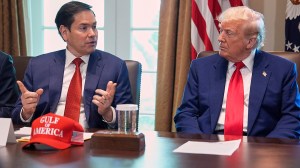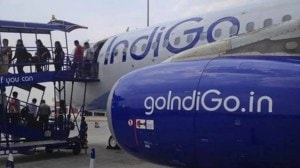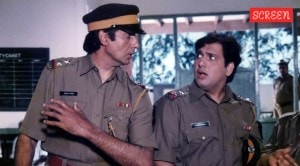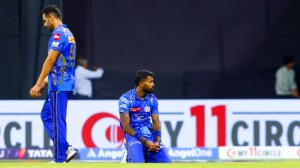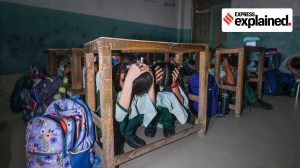UPSC Key: Indus Waters Treaty, Food Adulteration and Antitrust Laws
Why Cabinet Committee on Security is relevant to the UPSC exam? What is the significance of topics such as Bharat Stage emissions standards, India-US Bilateral Trade Agreement (BTA) and World Bank on both the preliminary and main exams? You can learn more by reading the Indian Express UPSC Key for April 24, 2025.
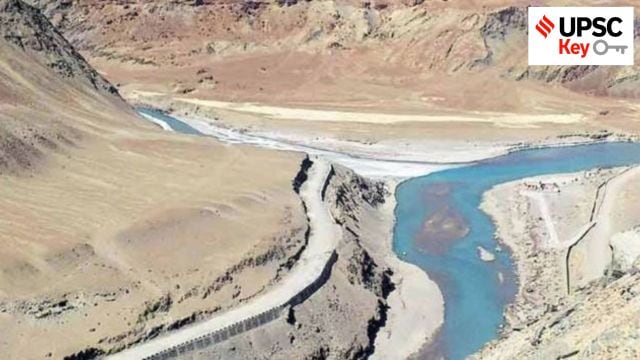 UPSC Key April 2025: Here's what you should be reading from the April 24, 2025 edition of The Indian Express
UPSC Key April 2025: Here's what you should be reading from the April 24, 2025 edition of The Indian Express
Important topics and their relevance in UPSC CSE exam for April 24, 2025. If you missed the April 23, 2025 UPSC CSE exam key from the Indian Express, read it here
FRONT PAGE
Govt suspends Indus treaty, expels Pak advisors, cancels visas, closes Attari
Syllabus:
Preliminary Examination: Current events of national and international importance.
Mains Examination: General Studies II: Government policies and interventions for development in various sectors and issues arising out of their design and implementation.
What’s the ongoing story: The Cabinet Committee on Security (CCS), India’s highest decision-making body on national security, has taken stringent actions against Pakistan following the discovery of cross-border links in the terror attack that killed 26 people, including a foreign national, in Pahalgam, Jammu and Kashmir.
Key Points to Ponder:
• What is the Cabinet Committee on Security?
• Who chairs Cabinet Committee on Security?
• What are the various Cabinet committees?
• Why is CCS so important?
• Discuss the role of the Cabinet Committee on Security (CCS) in India’s national security
• The Cabinet Committee on Security (CCS), has taken stringent actions against Pakistan—What are those actions?
• ‘India has implemented a 5-point action plan that targets Pakistan’s infrastructure, diplomatic presence, and movement across borders’—Discuss
Key Takeaways:
• In response to the attack, which has been linked to militant groups operating from Pakistan, India has implemented a 5-point action plan that targets Pakistan’s infrastructure, diplomatic presence, and movement across borders.
1. Suspension of the Indus Waters Treaty
India has decided to suspend the Indus Waters Treaty with Pakistan, which governs the sharing of river waters between the two countries. This suspension will remain in effect until Pakistan ceases its support for cross-border terrorism.
2. Closure of Attari-Wagah Border check post
India has shut the , halting all cross-border movement through this route. This includes suspending the movement of people and goods. Individuals who have already crossed over with valid documents will be allowed to return by 01 May 2025.
3. Cancellation of SAARC Visa exemption scheme (SVES) for Pakistan nationals
In a major blow to diplomatic exchanges, India has suspended the SAARC Visa Exemption Scheme (SVES) for Pakistani nationals. All previously issued SVES visas have been deemed cancelled.
Furthermore, Pakistani nationals who are currently in India under the scheme have been given a strict 48-hour deadline to leave the country.
4. Expulsion of Pakistani Military Advisors
India has expelled all Pakistani military, Naval, and Air advisors stationed at the Pakistani High Commission in New Delhi. These personnel have been declared Persona Non Grata and must vacate India within one week. In response, India will also withdraw its own military advisors from the Indian High Commission in Islamabad. This reciprocal move is part of a broader reduction of diplomatic engagement between the two nations.
5. Reduction of Diplomatic Personnel
As part of a continued effort to curtail bilateral diplomatic ties, India has announced a reduction in the overall strength of the Indian High Commission in Pakistan. The number of diplomatic personnel in Islamabad will be reduced to 30 by 01 May 2025, down from the current 55. This reduction will further limit the scope of bilateral interactions between the two countries.
Do You Know:
• According to The Cabinet Committee on Security (CCS) is a cabinet committee of the Government of India that discusses, debates and is the final decision-making body on senior appointments in the national security apparatus, defence policy and expenditure, and generally all matters of India’s national security
• The CCS meeting was attended by key government officials, including Home Minister Amit Shah, Defence Minister Rajnath Singh, External Affairs Minister S Jaishankar, and National Security Advisor Ajit Doval. The meeting focused on reviewing the ongoing security situation and deliberating on India’s response to the deadly attack.
• On the ground, the Indian Army and police forces have launched an extensive operation to track down the perpetrators of the attack. Preliminary reports suggest that the attack was carried out by a group of seven terrorists, including several Pakistani nationals, who opened fire on the unsuspecting tourists. Shah also visited the site of the attack in Pahalgam, as well as the hospital where the injured were being treated.
Other Important Articles Covering the same topic:
📍CCS takes measures against Pakistan on Pahalgam: What is the Cabinet Committee on Security?
Previous year UPSC Mains Question Covering similar theme:
📍The scourge of terrorism is a grave challenge to national security. What solutions do you suggest to curb this growing menace? What are the major sources of terrorist funding? (2017)
THE CITY
From Nov 1, no entry in Delhi for transport vehicles flouting norms
Syllabus:
Preliminary Examination: Economic and Social Development
Main Examination: General Studies III: Conservation, environmental pollution and degradation, environmental impact assessment.
What’s the ongoing story: Come November 1, all transport or commercial goods vehicles not compliant with BS-VI, CNG, LNG, or EV (electrical vehicle) standards will be banned from entering Delhi, unless the vehicles are registered in the Capital, the Commission for Air Quality Management (CAQM) has directed.
Key Points to Ponder:
• What you know about BS-VI, CNG, LNG, or EV (electrical vehicle) standards?
• What are Bharat Stage emissions standards?
• What is the Central Pollution Control Board (CPCB)?
• What is the Commission for Air Quality Management (CAQM)?
• Is CAQM a statutory body?
• What is the difference between BS-IV and BS-VI?
Key Takeaways:
• As the CAQM issued fresh directives on Wednesday to curb the menace of polluting vehicles, it also cited “limited progress” in impounding end-of-life or overaged vehicles across Delhi-NCR.
• The decision to restrict the transport vehicles, as per the directive, was made “considering the high pollution load from commercial vehicles and the associated ill effects of emissions owing to such vehicles entering Delhi…”
• From July 1, fuelling of identified overaged vehicles will be banned across all fuel stations in the city, among other stringent measures announced by the CAQM.
• This ban will extend to five high vehicle density (HVD) districts — Gurugram, Faridabad, Ghaziabad, Gautam Buddha Nagar, and Sonipat— from November 1, and across the rest of NCR from April 1, 2026, as per the CAQM directive. Diesel vehicles, older than 10 years, and petrol vehicles, older than 15 years, are not allowed to ply in the Capital.
• Over the last two years, the government has resorted to seizing these vehicles and scrapping them, if necessary. The Commission noted that despite several past orders, action on the ground has been sluggish.
• Delhi has been piloting a solution involving Automated Number Plate Recognition (ANPR) camera systems, now being installed at all 520 fuel stations in the city.
• These systems capture and display vehicle registration details in real-time. These are integrated with the centralised VAHAN database to identify EoL vehicles and those lacking a valid Pollution Under Control Certificate (PUCC), and relay audio alerts when a non-compliant vehicle is detected.
Do You Know:
• The Bharat Stage emission standards are standards instituted by the government to regulate the output of air pollutants from motor vehicles from internal combustion engine equipment, including motor vehicles. India has been following European (Euro) emission norms, although with a time lag of five years. The BS IV norms had been enforced across the country since April 2017. In 2016, the Centre had announced that the country would skip the BS-V norms altogether and adopt BS-VI norms by 2020. Implementation of the intermediate BS-V standard was originally scheduled for 2019.
• The main difference in standards between the existing BS-IV and the new BS-VI auto fuel norms is the presence of sulphur. The BS-VI fuel is estimated to bring around an 80 per cent reduction of sulphur, from 50 parts per million to 10 ppm. According to analysts, the emission of NOx (nitrogen oxides) from diesel cars is also expected to come down by nearly 70 per cent and 25 per cent from cars with petrol engines.
Other Important Articles Covering the same topic:
📍Explained: The problem with diesel
Previous year UPSC Prelims Question Covering similar theme:
1. How is the National Green Tribunal (NGT) different from the Central Pollution Control Board (CPCB)?
1. The NGT has been established by an Act whereas the CPCB has been created by an executive order of the Government.
2. The NGT provides environmental justice and helps reduce the burden of litigation in the higher courts whereas the CPCB promotes cleanliness of streams and wells, and aims to improve the quality of air in the country.
Which of the statements given above is/are correct?
(a) 1 only
(b) 2 only
(c) Both 1 and 2
(d) Neither 1 nor 2
THE EDITORIAL PAGE
Syllabus:
Preliminary Examination: Current events of national and international importance.
Main Examination: General Studies III: Role of external state and non-state actors in creating challenges to internal security
What’s the ongoing story: Haseeb A Drabu Writes: The break from the immediate past of the last three decades and the building of an alternative narrative cannot only be political or governmental. It has to be social
Key Points to Ponder:
• The 2025 Pahalgam attack—What you know so far?
• What immediate action did India take in response to the Pahalgam attack?
• What was a significant consequence of the Pahalgam attack on local tourism?
• “He desires peace. She deserves peace. They demand peace”—Discuss in the context of the article written by Haseeb A Drabu.
• “More needs to be done by the civil society of Kashmir. It is imperative to move beyond condemnation and disapproval”—What needs to be done?
• “Peace in Kashmir cannot be imported; it must be built from within.” Discuss the importance of local civil society in the peace process of Jammu and Kashmir.
• How targeted terror attacks like the Pahalgam incident on the socio-political fabric of Kashmir?
• How can educational institutions contribute to a culture of peace and tolerance in conflict-prone areas like Jammu and Kashmir?
Key Takeaways:
Haseeb A Drabu Writes:
• The local government has and will react to the massacre in the meadows of Pahalgam. The Union government will no doubt respond to it. The security establishment will retaliate in appropriate measure. As they all must, each in their own way. But it is not only about the government. What are the people of Kashmir to do? The massacre of tourists is as much against the government as it is against the people.
• There has been an all-round condemnation as there always has been. Already, political parties, trade bodies, business associations and professional groups have protested against the inhuman carnage. The Valley observed a shutdown, a complete Kashmir bandh.
• More needs to be done by the civil society of Kashmir. It is imperative to move beyond condemnation and disapproval.
• The revival of trade and commerce, which accounts for 40 per cent of the local economy, has been suddenly and brutally cut short and the livelihood of lakhs of families has been seriously impaired. Last week, a hailstorm damaged and destroyed the apple crop and impaired the livelihood and prosperity of lakhs of Kashmiris. J&K is in for serious economic distress.
• The recent surge in investment — official figures for investments in 2023-24 are almost Rs 3,500 crore with Rs 1.75 lakh crore in the works with the potential to create 6.06 lakh jobs — will now be in jeopardy.
• While there is a staggering economic loss, the real loss is much more. Kashmir can survive without the income from tourism, but it can’t live with its societal value system being as severely damaged and compromised as was done in Pahalgam.
• It is the soul of Kashmir that has been bruised, battered, and sinned against in Pahalgam. The atonement in private sought by every Kashmiri today will become a collective effort for a peaceful, liberal and tolerant society. From there, a people’s narrative will emerge.
Do You Know:
Ajai Sahni Writes:
• The attack at the Baisaran meadow near Pahalgam, where at least 25 tourists and a Valley resident were killed, reflects a significant departure in the trajectory of terrorism in Jammu & Kashmir (J&K). It is a breakdown of the unwritten compact between virtually all terrorist groups operating in the now Union Territory and the larger population there — that tourists would not be targeted.
• Virtually every family in the Valley is directly or indirectly dependent on tourism, and a collapse of the industry would inflict unendurable hardships on the entire population.
• The South Asia Terrorism Portal (SATP), for instance, records a total of 24 incidents targeting tourists since 2000, of which 13 were incidents of killing, resulting in 44 fatalities. This excludes the latest incident in Pahalgam. Significantly, these numbers include Hindu pilgrims, who have never been part of the “implicit compact” excluding tourists as targets of terrorism.
• The most significant damage the Pahalgam incident will inflict is on the Centre’s narrative of the restoration of “normalcy” in J&K after the abrogation of Article 370 in August 2019. At the time, the Ministry of Home Affairs (MHA) promised “zero terrorism” in the Union Territory, and boastful assertions of burgeoning tourism as an index of such success were made — 23.6 million tourists visited J&K in 2024. The number was expected to be exceeded in the current year before the Pahalgam incident. Clearly, however, such “normalcy” and “zero terrorism” remain elusive.
• There can be no magical “solution” to the “Kashmir issue” as long as Pakistan continues to provide support to separatism and a measure of alienation persists in the UT. But a “solution” is already in play. The drop in fatalities from 4,011 to 127 is, itself a “solution”, a major success, and within a theatre of protracted conflict, a measure of “normalcy”.
• The Pahalgam attack is, no doubt, an unacceptable outrage, and there will be consequences. Pakistan has sought to deny involvement, but all present indications suggest the involvement of The Resistance Front (TRF), a front organisation of the Lashkar-e-Taiba (LeT).
• The scale and nature of the operation, as well as the profile of the participating terrorists, at least three of whom have already been named by authorities, clearly indicate TRF/LeT involvement, built on Pakistani state support, if not immediate planning and oversight.
Other Important Articles Covering the same topic:
Syllabus:
Preliminary Examination: Current events of national and international importance.
Main Examination: General Studies II: Food processing and related industries in India- scope’ and significance, location, upstream and downstream requirements, supply chain management.
What’s the ongoing story: Rituparna Patgiri Writes: The state must deal with the challenge, not put onus on citizens.
Key Points to Ponder:
• What is food adulteration and its types?
• According to the Food Safety and Standards Act of 2006 (FSSA), what are the current requirements for food safety?
• What are the FSS Act of 2006’s General Provisions to Prevent Food Adulteration?
• How food adulteration contribute to the burden of communicable and non-communicable diseases?
• Evaluate the effectiveness of existing legal frameworks in addressing food adulteration.
Key Takeaways:
Rituparna Patgiri Writes:
• Food is one of the most significant aspects of our social and cultural lives, and both state and society play crucial roles in determining nutrition and health-related policies.
• As per the recent National Family Health Survey (NFHS-5, 2019-21), in children under five, the rate of stunting is at 35.5 per cent, wasting at 19.3 per cent and underweight prevalence at 32.1 per cent. Despite such evidence, nutrition and public health remain neglected. A similar apathy about food quality may explain why there is no outrage over food adulteration, which should be a grave concern for public health.
• In the 1990s, it was common to hear stories about adulterated milk. In 2025, the adulteration of food, including milk, remains a problem. For instance, the National Survey on Milk Adulteration in 2011 revealed that 70 per cent of the milk samples that were tested in India did not meet the standards of food safety. Water is the main adulterant in milk. Other adulterants include salt, detergents and glucose.
• In recent times, there have been alarming reports on food adulteration in several other items of daily consumption like paneer, watermelon, spices, etc. News reports from different parts of the country, like Delhi, Mumbai, and Noida, have revealed that the market is flooded with “fake paneer”. The most common adulterants include starch, detergents, synthetic milk, acetic acid, etc. Eating adulterated food items can lead to severe health consequences like food poisoning, sometimes even death.
Do You Know:
• The prevalence of adulterated food should set alarm bells ringing in a country that is grappling with both communicable and non-communicable health issues. India is often known as the diabetes capital of the world, with around 77 million people above 18 suffering from this non-communicable disease. A recent study by the Indian Council of Medical Research and the Madras Diabetes Research Foundation, Chennai, has attributed this to the kind of food Indians eat. The higher number of diabetics is closely connected to the fried and ultra-processed foods that are consumed. The use of low-quality oil is also a contributing factor. Edible oil is also one of the most adulterated food items in the country. Adulterants such as rice bran oil, argemone oil and artificial allyl isothiocyanate are added to mustard oil.
• The case of adulteration in spices is even more striking. In April 2024, Hong Kong suspended the sale of certain MDH and Everest spice blends because of the presence of large amounts of ethylene oxide, a cancer-causing pesticide. It is not an exaggeration to state that Indian soft power, especially its culinary capital, is synonymous with its spices. Made-in-India spices, considered to be one of the major exports, are widely sold worldwide. Apart from health impacts, the country’s international reputation suffers when these cases come up. The European Union has already raised concerns about the presence of ethylene oxide in chilli peppers and peppercorns from India. It even banned 400 items for heavy contamination between 2019 and 2024.
• The Food Safety and Standards Authority of India (FSSAI) has been conducting raids and sample tests and cancelling the manufacturing licences of many manufacturers.
Other Important Articles Covering the same topic:
📍Detect adulteration in milk with this foolproof test
Previous year UPSC Prelims Question Covering similar theme:
2. Consider the following statements: (2018)
1. The Food Safety and Standards Act, 2006 replaced the Prevention of Food Adulteration Act, 1954.
2. The Food Safety and Standards Authority of India (FSSAI) is under the charge of Director General of Health Services in the Union Ministry of Health and Family Welfare.
Which of the statements given above is/are correct?
(a) 1 only
(b) 2 only
(c) Both 1 and 2
(d) Neither 1 nor 2
3. Consider the following pairs:
| Commonly used/consumed materials |
Unwanted or controversial chemicals likely to be found in them |
||
| 1. | Lipstick | — | Lead |
| 2. | Soft Drinks | — | Brominated vegetable oils |
| 3. | Chinese fast food | — | Monosodium glutamate |
Which of the pairs given above is/are correctly matched?
(a) 1 only
(b) 2 and 3 only
(c) 1 and 3 only
(d) 1, 2 and 3
ECONOMY
India-US BTA talks begin in Washington
Syllabus:
Preliminary Examination: Current events of national and international importance.
Main Examination: General Studies II: Bilateral, regional and global groupings and agreements involving India and/or affecting India’s interests.
What’s the ongoing story: The first in-person meeting between the chief negotiators of the Bilateral Trade Agreement (BTA) between India and US after the finalisation of terms of reference (ToR) got underway on Wednesday, in Washington with both sides aiming to iron out issues for a faster deal over the next three days.
Key Points to Ponder:
• What is the primary objective of the India-US Bilateral Trade Agreement (BTA)?
• India-US Bilateral Trade Agreement (BTA)—what you know about the same?
• Discuss the significance of the India-US Bilateral Trade Agreement (BTA) talks in the context of global trade dynamics and India’s economic interests.
• Assess the role of tariff disparities between India and the US in shaping the negotiations and the possible outcomes of the BTA.
• Propose measures that India can adopt to safeguard its domestic industries while engaging in comprehensive trade agreements like the BTA.
Key Takeaways:
• Apart from the scope of liberalisation, modalities and scheduling of negotiations to complete them within the autumn deadline will also be discussed. While negotiators meet in person, experts from both sides remain engaged digitally to aid the process.
• Both sides are also attempting to cover as much ground as possible in the 90-day period of pause in reciprocal tariffs to reach some kind of an interim trade agreement or understanding with the US. If the progress is slow then there is possibility that Indian exports to the US will be subject to additional duties. Under the reciprocal plan US has announced 26% additional duties on India but its full implementation has been put on hold.
• The US has been vocal about its demands from New Delhi on agriculture, auto and overall trade deficit. In a statement on Tuesday, the US Trade Representative Jamieson Greer again stated, ““There is a serious lack of reciprocity in the trade relationship with India. These ongoing talks will help achieve balance and reciprocity by opening new markets for American goods and addressing unfair practices that harm American workers.”
• Officials say that India too has certain asks from the US in the BTA. In some sectors like tobacco and peanut butter the US imposes very high tariffs and other restrictions. In textile, clothing and other items of Indian export basket too there is not much difference between Indian and US rates.
• In 2024-25 India’s merchandise exports to the US grew 11.6% on year to $ 86.51 billion while imports grew 7.4% to $ 45.3 billion. This resulted in a surplus of $ 41.21 billion for India. To balance that trade one of the options that has been proposed is India buying more petroleum and defence items from the US.
• The ToR has 19 chapters each dealing with a different topic like goods, services, non-tariff barriers, rules of origin, customs facilitation, dispute settlement and regulatory issues. During the visit the ToR would be further developed, an official said.
Do You Know:
• This is not the first time India and the US have agreed to explore the possibility of a trade agreement. However, the US-led 14-member Indo-Pacific Economic Framework for Prosperity (IPEF), of which India is a part, could not agree on the “trade pillar” of the IPEF in 2022 as it did not offer tariff reductions or increased access to the US market.
• Due to job losses in several areas — particularly the United States’ industrial belt following China’s entry into the WTO — sentiment among US lawmakers has turned against granting more market access to foreign goods.
• A paper by the US-based think tank National Bureau of Economic Research titled ‘Importing Political Polarisation and Electoral Consequences of Rising Trade Exposure’ (2017) stated that growing import competition from China has contributed to a shift to the right in the political beliefs of US adults.
—The paper also noted that in the 2016 presidential election, trade shocks increased the vote share of the Republican candidate — Donald Trump.
• Trade experts suggest that a BTA would likely require India to lower tariffs to allow greater entry of American goods, rather than the US reciprocating, as average tariffs in the US are already among the lowest in the world.
• Think tank Global Trade Research Institute (GTRI) said this is not the best time for a trade deal with the US, as the current regime simply does not respect FTAs. This is illustrated by the Trump administration’s imposition of tariffs on Mexico and Canada on steel and aluminium “in violation of United States-Mexico-Canada Agreement (USMCA) provisions,” GTRI said.
• A 2022 report by think tank Delhi Policy Group (DPG) highlighted that tariff imbalances were a key reason why ASEAN countries export more to India than they import from it.
Other Important Articles Covering the same topic:
📍Modi-Trump meeting: What would a trade deal with the US mean for India?
Previous year UPSC Prelims Question Covering similar theme:
4. Consider the following countries:
1. Australia
2. Canada
3. China
4. India
5. Japan
6. USA
Which of the above are among the ‘free-trade partners’ of ASEAN?
(a) 1, 2, 4 and 5
(b) 3, 4, 5 and 6
(c) 1, 3, 4 and 5
(d) 2, 3, 4 and 6
World Bank sees FY26 growth at 6.3% on global weakness, policy uncertainty
Syllabus:
Preliminary Examination: Current events of national and international importance.
Main Examination: General Studies II: Important International institutions, agencies and fora- their structure, mandate.
What’s the ongoing story: The World Bank has cut India’s growth forecast by 0.4 percentage points to 6.3 per cent from 6.7 per cent for the current financial year 2025-26, citing global economic weakness and policy uncertainty.
Key Points to Ponder:
• The World Bank has cut India’s growth forecast by 0.4 percentage points to 6.3 per cent from 6.7 per cent for the current financial year 2025-26—Why?
• What are the primary reasons cited by the World Bank for lowering India’s FY26 growth forecast to 6.3%?
• What was India’s GDP growth rate in FY24/25, as per the World Bank’s report?
• According to the World Bank, what is a significant fiscal challenge for India contributing to macroeconomic instability?
• What is the title of the World Bank’s April 2025 South Asia Development Update?
• According to the World Bank, what is a necessary reform for South Asian countries to withstand global economic challenges?
• What could be the implications of the World Bank’s revised growth forecast for India in FY26?
Key Takeaways:
• It is seen slowing from 6.5 per cent growth estimate (7.0 per cent earlier) in FY25, the Bank said in its latest South Asia Development Update on Wednesday.
• “In India, growth is expected to slow from 6.5 per cent in FY25 to 6.3 per cent as in FY26 as the benefits to private investment from monetary easing and regulatory streamlining are expected to be offset by global economic weakness and policy uncertainty,” the World Bank said.
• The downgrade in India’s growth projections by the Bank comes just a day after the International Monetary Fund (IMF) also cut the growth forecast for India. The IMF had lowered India’s growth estimate by 0.3 percentage points to 6.2 per cent from 6.5 per cent for FY26 and by 0.2 percentage points to 6.3 per cent from 6.1 per cent for FY27.
• The estimates are lower than the 6.5 per cent growth projection by the Reserve Bank of India (RBI) for FY26. As per the RBI, the real GDP growth for India for FY26 is seen to be lower than the earlier projection of 6.7 per cent, with Q1 growth seen at 6.5 per cent; Q2 at 6.7 per cent; Q3 at 6.6 per cent; and Q4 at 6.3 per cent.
• Growth was affected in the previous financial year 2024-25 due to slower pace of private investment and public capital expenditure falling short of targets set by the government, the Bank said.
• The government has announced fiscal consolidation but also tax cuts to support private consumption and regulatory streamlining to spur private investment, it said. However, the benefits to private investment from monetary easing and regulatory streamlining are expected to be offset by global economic weakness and policy uncertainty, it said.
Do You Know:
• Commenting on the debt position in South Asia, the Bank said governments in India, Maldives, Pakistan, and Sri Lanka are already liable for above-average net interest payments relative to GDP, and will seek to finance fiscal deficits of between 7-17 per cent of GDP in 2025. “In some countries, growing debt service pressures could generate cycles of rising risk premia and debt distress,” it said.
• Overall, growth in South Asia is expected to soften to 5.8 per cent in 2025, 0.4 percentage point below October forecasts before rising to 6.1 per cent in 2026.
• The region’s economies face heightened downside risks, including from a highly uncertain global landscape, it said.
• Growth is projected to be slower for India’s neighbours such as Bangladesh, where the growth is seen slowing to 3.3 per cent in FY25 amid political uncertainty and persistent financial challenges, and then a pickup to 4.9 per cent in FY26.
• In Bhutan, the growth forecast for FY25 has been downgraded to 6.6 per cent due to weak agriculture sector growth but upgraded in FY26 to 7.6 per cent due to expected strength in hydropower construction.
Other Important Articles Covering the same topic:
📍Why reforms have been proposed for World Bank, other Multilateral Development Banks; what they say
Previous year UPSC Prelims Question Covering similar theme:
5. The Global Infrastructure Facility is a/an (2017)
(a) ASEAN initiative to upgrade infrastructure in Asia and financed by credit from the Asian Development Bank.
(b) World Bank collaboration that facilitates the preparation and structuring of complex infrastructure Public-Private Partnerships (PPPs) to enable mobilization of private sector and institutional investor capital.
(c) Collaboration among the major banks of the world working with the OECD and focused on expanding the set of infrastructure projects that have the potential to mobilize private investment.
(d) UNCTAD funded initiative that seeks to finance and facilitate infrastructure development in the world.
6. India’s ranking in the ‘Ease of Doing Business Index’ is sometimes seen in the news. Which of the following has declared that ranking? (2016)
(a) Organization for Economic Cooperation and Development (OECD)
(b) World Economic Forum
(c) World Bank
(d) World Trade Organization (WTO)
THE WORLD
Meta, Apple get €700 mn fine for violating EU antitrust rules
Syllabus:
Preliminary Examination: Current events of national and international importance.
Main Examination: General Studies II: Effect of policies and politics of developed and developing countries on India’s interests
What’s the ongoing story: Apple was fined 500 million euros ($570 million) on Wednesday and Meta 200 million euros, as European Union antitrust regulators handed out the first sanctions under landmark legislation aimed at curbing the power of Big Tech.
Key Points to Ponder:
• What are antitrust laws in the EU?
• Why Meta, Apple get €700 mn fine for violating EU antitrust rules?
• Which legislation did the European Union invoke to fine Apple and Meta in April 2025?
• Which practice led to Apple’s fine under the Digital Markets Act (DMA)?
• What was the primary reason for Meta’s fine under the DMA?
• What is the primary objective of the Digital Markets Act (DMA)?
• Assess the challenges faced by regulatory bodies in enforcing antitrust laws on multinational tech giants.
Key Takeaways:
• The EU fines could stoke tensions with U.S. President Donald Trump who has threatened to levy tariffs against countries that penalise U.S. companies. Trump’s White House called the fines a “novel form of economic extortion” that the United States will not tolerate.
• They follow a year-long investigation by the European Commission, the EU executive, into whether the companies comply with the Digital Markets Act (DMA) that seeks to allow smaller rivals into markets dominated by the biggest companies.
• The fines signal that the EU is sticking to its guns in enforcing the new rules, which were introduced in 2023. That is despite Trump citing the DMA while vowing in February to “defend American companies and innovators from overseas extortion”.
• The EU will be encouraged by a U.S. court judgment earlier this month which found that Google illegally dominates two markets for online advertising technology, Commission sources say. That ruling could pave the way for U.S. antitrust prosecutors to seek a breakup of its ad products.
Do You Know:
• According to the Competition Policy of EU, Antitrust rules prohibit agreements between market operators that would restrict competition, and the abuse of dominance. European Antitrust policy is developed from two central rules set out in the Treaty on the Functioning of the European Union:
—Article 101 of the Treaty prohibits agreements between two or more independent market operators, which restrict competition. The most flagrant example of illegal conduct infringing Article 101 is the creation of a cartel between competitors, which may involve price-fixing and/or market sharing.
—Article 102 of the Treaty prohibits firms that hold a dominant position on a given market to abuse that position, for example by charging unfair prices, by limiting production, or by refusing to innovate to the prejudice of consumers.
• Apple avoided a fine in a separate investigation into its browser options on iPhones after making changes that allow users to switch to a rival browser or search engine more easily. Regulators said these comply with the DMA and closed the investigation on Wednesday.
• The iPhone maker was still charged with breaching DMA rules on the grounds it hindered users from sideloading, a practice that involves downloading alternative app stores and apps from the web.
Other Important Articles Covering the same topic:
📍Commission finds Apple and Meta in breach of the Digital Markets Act
Previous year UPSC Prelims Question Covering similar theme:
7. Consider the following statements: (2023)
Statements-I: Recently, the United States of America (USA) and the European Union (EU) have launched the ‘Trade and Technology Council’.
Statement-II: The USA and the EU claim that through this they are trying to bring technological progress and physical productivity under their control.
Which one of the following is correct in respect of the above statements?
(a) Both Statement-I and Statement-II are correct and Statement-II is the correct explanation for Statement-I
(b) Both Statement-I and Statement-II are correct and Statement-II is not the correct explanation for Statement-I
(c) Statement-I is correct but Statement-II is incorrect
(d) Statement-I is incorrect but Statement-II is correct
EXPLAINED
Why India’s suspension of 65-year-old Indus Waters Treaty is significant
Syllabus:
Preliminary Examination: Current events of national and international importance.
Main Examination: General Studies II: India and its neighbourhood- relations.
What’s the ongoing story: The Indus Waters Treaty (IWT), which has survived four wars, decades of cross-border terrorism against India by Pakistan, and a long history of antagonism between the two countries, was suspended for the first time by New Delhi.
Key Points to Ponder:
• What is Indus Waters Treaty?
• What are the “Eastern Rivers” and “Western Rivers” of the Indus system?
• Map Work—the “Eastern Rivers” and “Western Rivers” of the Indus system
• Know the strategic implications of India’s suspension of the Indus Waters Treaty on bilateral relations with Pakistan.
• What are the legal challenges associated with the unilateral suspension of international treaties, with reference to the Indus Waters Treaty?
• Evaluate the potential impact of the Indus Waters Treaty suspension on Pakistan’s agricultural sector and overall food security.
• Discuss the environmental and humanitarian concerns arising from disruptions in transboundary water treaties.
Key Takeaways:
• India made its decision a day after the attack on tourists in Pahalgam, in which Pakistani terrorists took the lives of 26 people.
• “The Indus Waters Treaty of 1960 will be held in abeyance with immediate effect, until Pakistan credibly and irrevocably abjures its support for cross-border terrorism,” Foreign Secretary Vikram Misri said on Wednesday evening.
• Among the slew of diplomatic actions against Pakistan announced by India — including the closure of the Attari border post, cancellation of visas, and the expulsion of several Pakistani personnel from India – the suspension of the IWT may have the most far-reaching ramifications.
Do You Know:
• The IWT was signed in Karachi on September 19, 1960, following nine years of negotiations between India and Pakistan. The Treaty has 12 Articles and 8 Annexures (from A to H).
According to the provisions of the Treaty, all the water of the “Eastern Rivers” of the Indus system — Sutlej, Beas and Ravi — shall be available for the “unrestricted use” of India. Pakistan shall receive water from the “Western Rivers” — Indus, Jhelum, and Chenab.
• The decision to suspend the IWT will straightaway give more options to New Delhi on how to use the waters of the Indus river system. “For instance, India can immediately stop sharing water flow data with Pakistan. There will be no design or operational restrictions on India for the use of the water of the Indus and its tributaries. Also, India can now create storage on the Western Rivers, Indus, Jhelum and Chenab,” P K Saxena, former Indian Commissioner for Indus Waters, told The Indian Express.
• India can also stop visits by Pakistani officials to the two hydroelectric projects currently under construction in Jammu & Kashmir — the Kishenganga HEP on Kishenganga, a tributary of the Jhelum, and the Ratle HEP on the Chenab — Saxena said.
• However, the suspension will not have an immediate impact on the flow of water to Pakistan for a few years at least. India does not currently have the infrastructure to either stop the flow of water into Pakistan, or to divert it for its own use
• The Indus Waters Treaty lacks an exit clause, meaning neither India nor Pakistan can legally abrogate it unilaterally.
• The Treaty has no end date, and any modification requires the consent of both parties.
But while the Treaty cannot be exited, it does contain a dispute resolution mechanism: Article IX, along with Annexures F and G, lays out procedures for raising grievances — first before the Permanent Indus Commission, then a neutral expert, and eventually, a forum of arbitrators.
• The two hydroelectric projects in Jammu and Kashmir have been a bone of contention between India and Pakistan for years now, leading New Delhi to issue a notice, in January 2023, to Islamabad seeking the “modification” of the Treaty.
Other Important Articles Covering the same topic:
📍Desperate step in desperate times: Pak’s intent behind Pahalgam attack
Previous year UPSC Prelims Question Covering similar theme:
8. With reference to the Indus river system, of the following four rivers, three of them pour into one of them which joins the Indus directly. Among the following, which one is such a river that joins the Indus direct? (2021)
(a) Chenab
(b) Jhelum
(c) Ravi
(d) Satluj
| PRELIMS ANSWER KEY |
| 1. (b) 2.(a) 3.(d) 4.(c) 5.(b) 6.(c) 7.(c) 8.(d) |
For any queries and feedback, contact priya.shukla@indianexpress.com
Subscribe to our UPSC newsletter. Stay updated with the latest UPSC articles by joining our Telegram channel – IndianExpress UPSC Hub, and follow us on Instagram and X.
Must Read
Buzzing Now
May 07: Latest News
- 01
- 02
- 03
- 04
- 05




